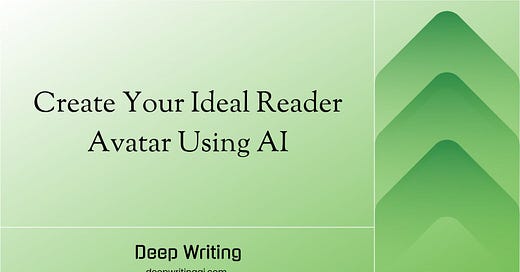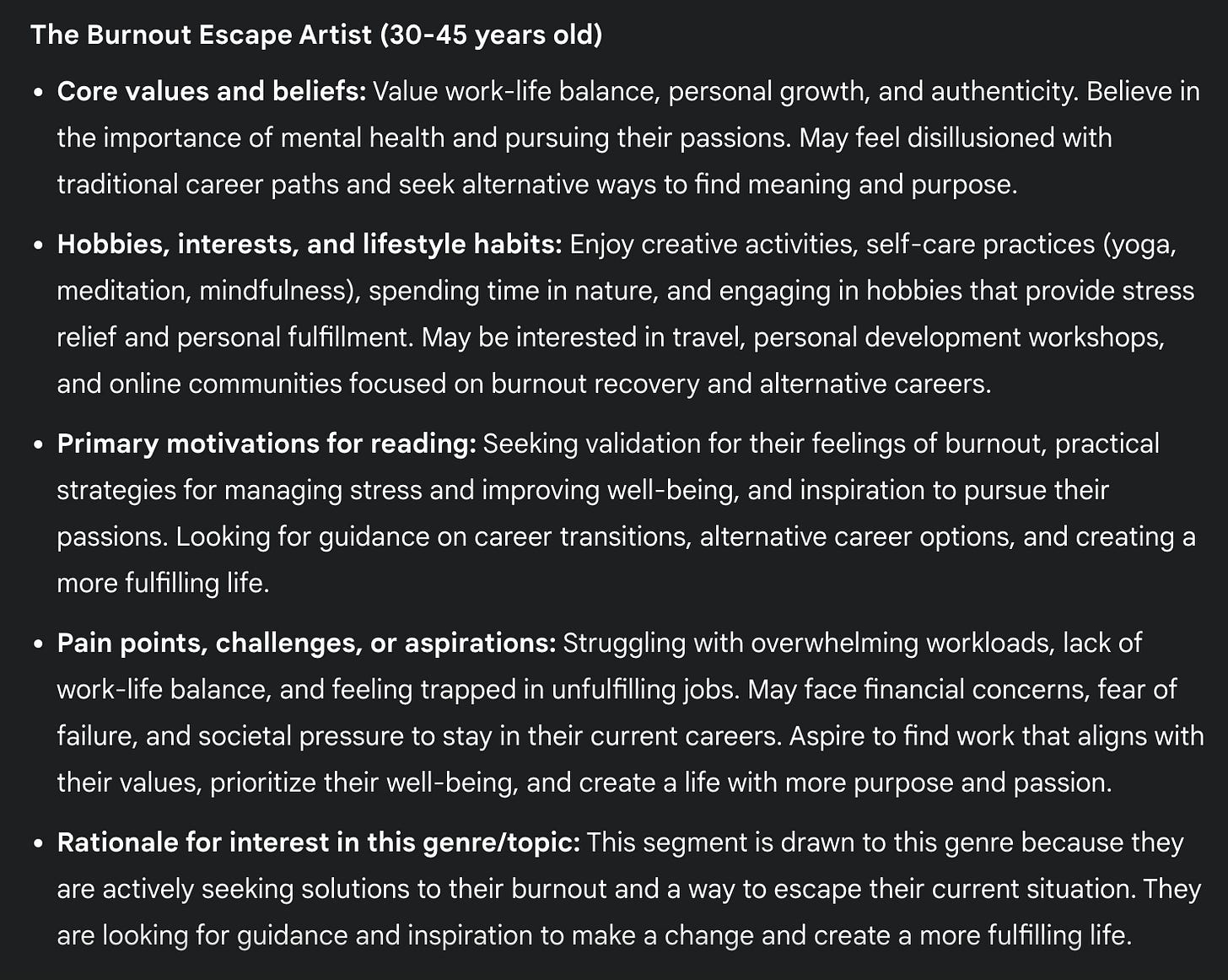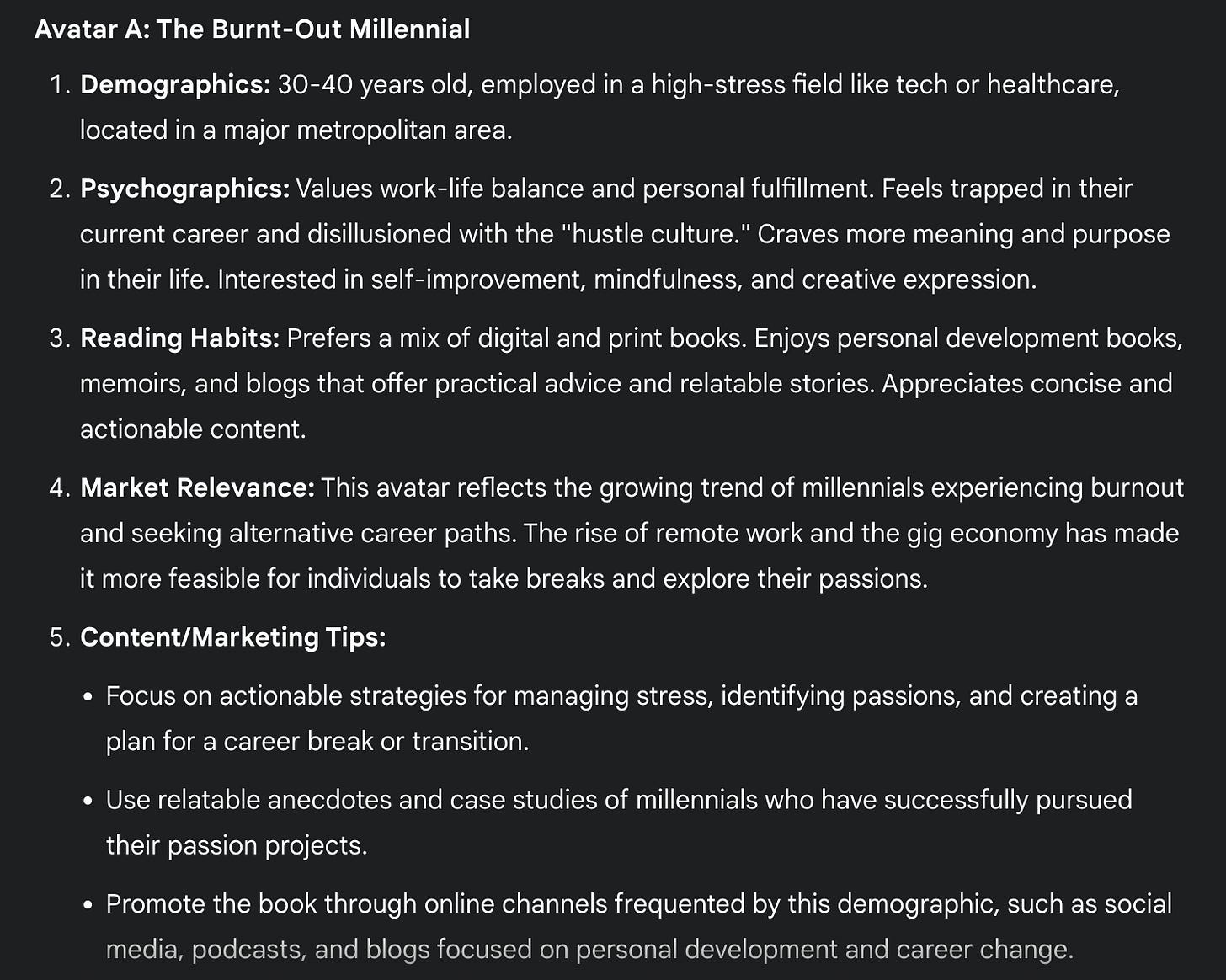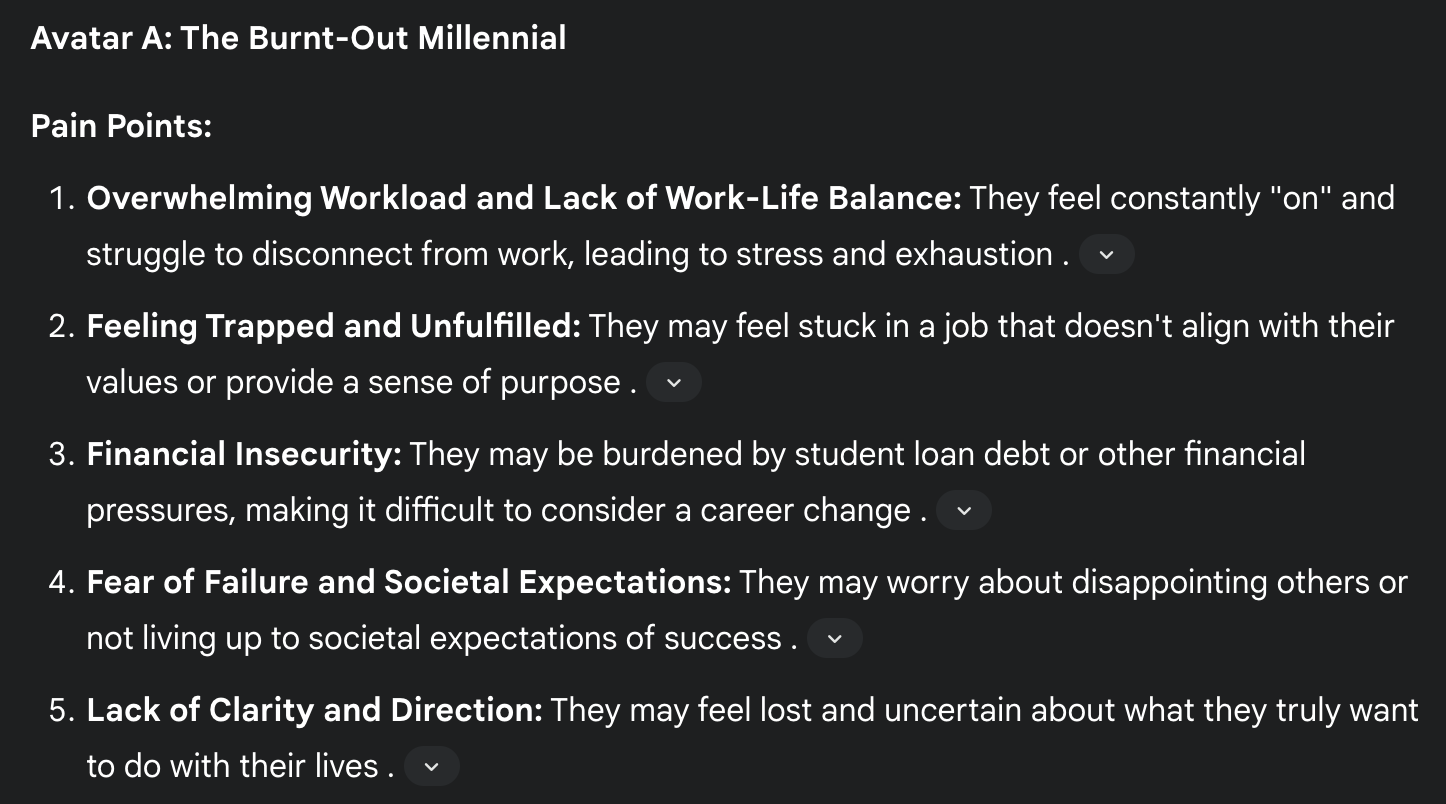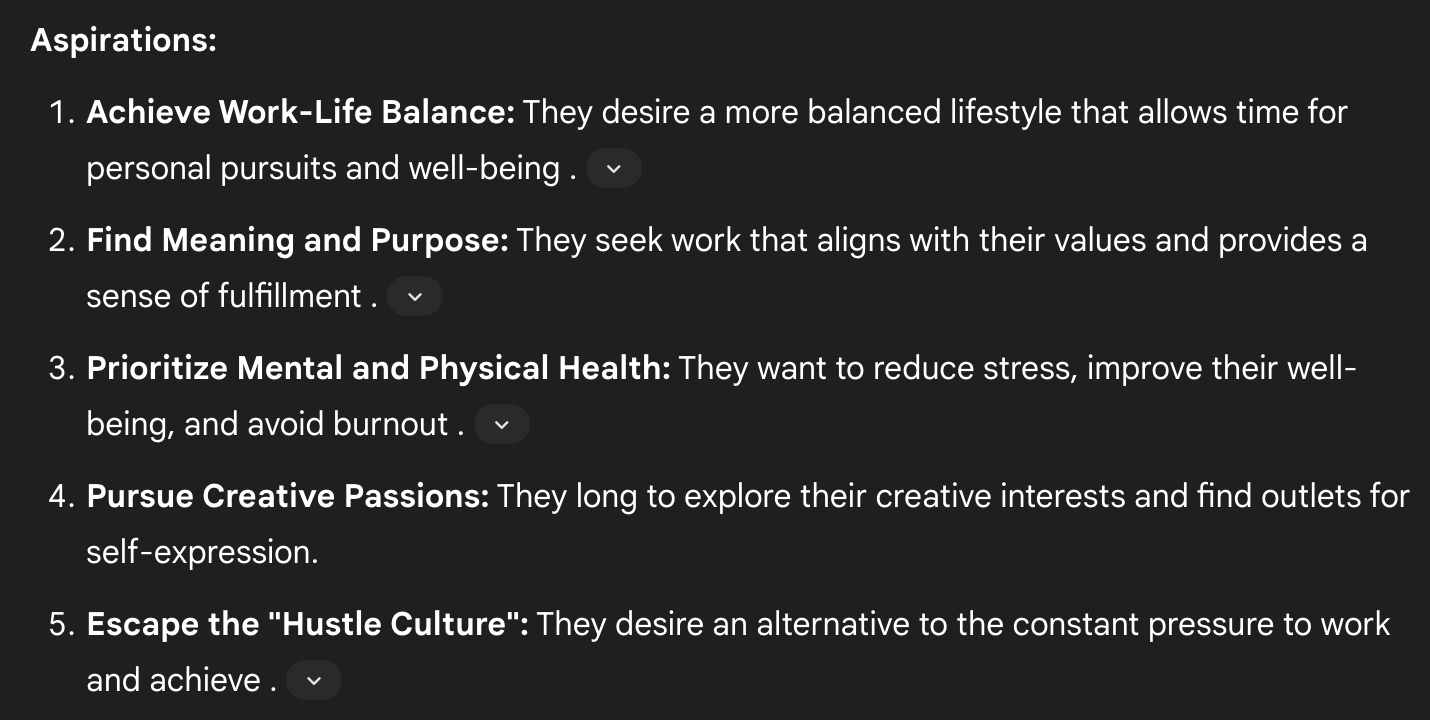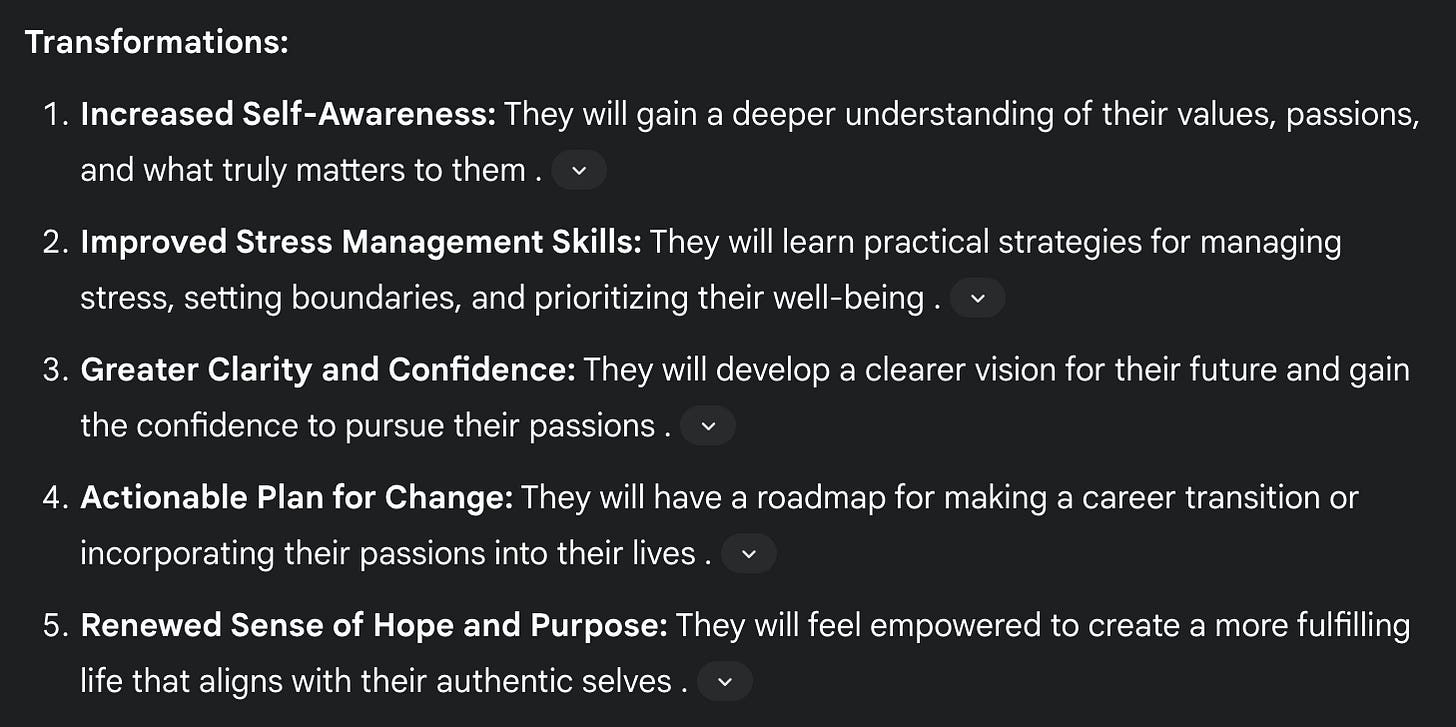How to Create Your Ideal Reader Avatar Using AI
Stop guessing who your audience is—use AI to define and reach them with precision.
Welcome to the depths, Deep Writers.
I’ve been reading a bit about the craft of writing lately, and one piece of advice keeps surfacing:
“Before writing anything — be it an article or a book — you must define your ideal reader. Keep in mind that one individual, your avatar, when telling your story.”
This makes perfect sense because knowing the ideal reader would help us speak directly to them and inspire action.
Writers have traditionally relied on frameworks like demographics, psychographics, pain points, and aspirations to create reader personas.
But here’s the challenge: doing this intuitively is like shooting in the dark.
Does your ideal reader exist in sufficient numbers? Are you missing crucial aspects of their psychology? Are there better target audiences you haven't considered?
So, I created a framework to use AI to transform this traditionally intuitive process into a systematic, data-informed approach.
We’ll use Google Deep Research for this because of its powerful research capabilities. (Check out this article on Deep Research if you missed it.)
Let’s walk through this framework using a real example: say we want to write a nonfiction book on “taking a break from work to pursue a passion project.”
Thanks for reading Deep Writing! Subscribe for more actionable strategies to harness AI and elevate your nonfiction writing.
Step 1: Demographics & Market Overview
First, let’s figure out who we’re writing for.
This step is about getting a clear picture of their age, location, profession, and general interests. This sets the stage so everything we write feels like it’s speaking to the right people from the start.
Here’s the prompt:
You are an expert in publishing market research and audience analysis.
Given the following inputs:
- Genre: [GENRE]
- Topic: [TOPIC]
1. Identify major market segments that typically read books in this genre/topic.
2. Provide a concise overview of the top 2–3 demographic profiles within these segments, including age range, education, typical professions, and general location (urban, suburban, rural).
Consider only Reddit discussions.Quick Note: I specifically mentioned Reddit because I wanted real conversations from actual people discussing this topic. You can remove this or tailor it to include specific platforms relevant to you.
When I ran this prompt, Deep Research analyzed 41 threads and revealed three distinct profiles:
The Burnout Escape Artist:
Age: 30-45 years old
Education: Bachelor’s or higher
Professions: High-stress roles in tech, healthcare, finance, law
Location: Urban and suburban areas
Key Motivations: Escaping burnout, finding work-life balance, pursuing creative outlets
The Mid-Career Reinventor:
Age: 40-55 years old
Education: Bachelor’s or Master’s degree
Professions: Established roles in management, education, consulting
Location: Suburban and urban areas
Key Motivations: Seeking new challenges, pursuing personal growth, leaving a legacy
The Aspiring Entrepreneur:
Age: 25-40 years old
Education: Varied, from some college to advanced degrees
Professions: Diverse backgrounds with entrepreneurial mindset
Location: Urban areas with strong startup ecosystems
Key Motivations: Building something meaningful, achieving financial independence
Step 2: Understanding Reader Psychology
Now that we know who they are demographically, let’s go deeper into what drives them, what they care about, and why they read.
Use this prompt in the same thread.
Based on the demographic profiles provided earlier:
1. Describe the typical psychographics of each demographic segment:
- Core values and beliefs
- Hobbies, interests, and lifestyle habits
- Primary motivations for reading books in this genre/topic
2. Suggest what specific pain points, challenges, or aspirations these readers may have.
3. Provide a short rationale for why each demographic would be drawn to a book in this genre/topic.Deep Research gave me a detailed breakdown of the psychographics of each of the demographic profiles identified earlier.
Let’s look at The Burnout Escape Artist, as it’s emerging as our most promising avatar:
Step 3: Identifying Best-Fit Avatars
Let’s now combine the demographics and psychographics data to pinpoint which avatar(s) have the greatest potential for market success.
Here’s the prompt:
From your analysis, recommend 1–2 ideal reader avatars that are most likely to ensure market success.
For each recommended avatar:
1. Summarize demographics (age range, occupation, location).
2. Highlight key psychographic traits (values, lifestyle, motivations).
3. Note their typical reading habits or preferences.
4. Explain why this avatar is a strong candidate in the current market, including any relevant trends.
5. Offer 2–3 concrete tips for how an author can tailor content or marketing to engage this avatar effectively.
Structure your final output as two distinct profiles, each labeled 'Avatar A' and 'Avatar B,'
and keep each profile to approximately 200 words.From this analysis, our ideal reader emerges clearly: The Burnt-Out Millennial
Step 4: Pain Points, Aspirations, Transformations
Finally, we’ll detail exactly how our book will transform our ideal reader.
Choose the ideal avatar from above, and use this prompt:
Consider [Avatar]
1. List 3-5 pain points that we will solve for this reader through the book.
2. What are the 3-5 aspirations that this reader has?
3. What are the 3-5 transformations that this reader will experience after reading the book?This step bridges the gap between market research and actual writing. It gives you a clear “before and after” picture that will guide your content creation.
Pain points we’ll address:
Their core aspirations:
The transformations we’ll promise:
By the time you finish this process, you’ll have a clear, three-dimensional profile that practically jumps off the page. Imagine how much easier it will be to write when you know exactly who you’re talking to.
As we wrap up this year, your future readers are out there, waiting for the words only you can write for them.
Want personalized help implementing AI in your writing process?
I offer 90-minute sessions where we build your custom AI content system together.

